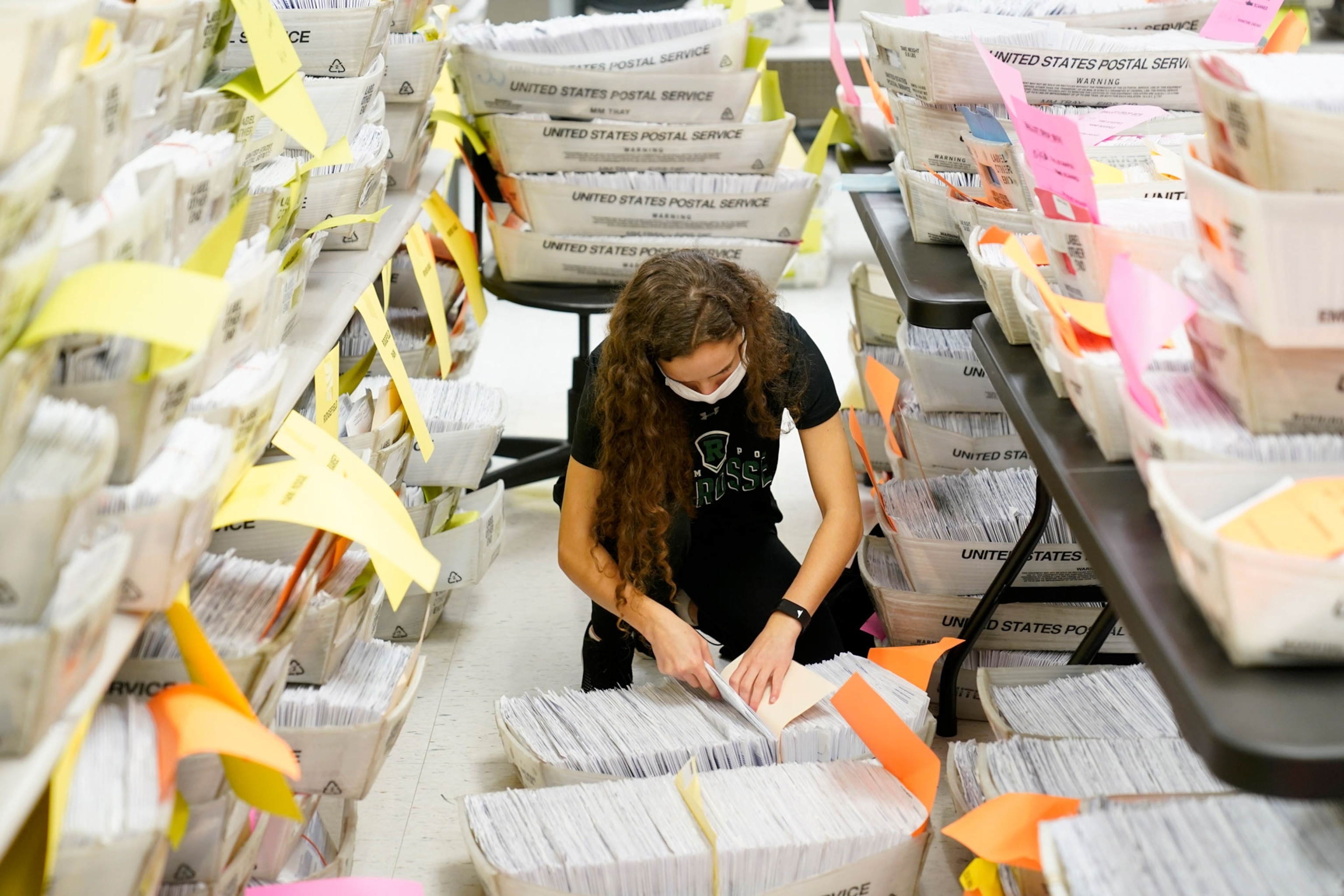
Here’s what happens if there isn’t a winner on Election Day
After a disastrous presidential election in 1876, the U.S. devised a system to resolve electoral disputes. Here's how that process works—and why it, too, has been controversial.
Every four years, presidential campaigns follow a familiar cadence of debates, speeches, rallies, and political ads leading up to the main event in early November. But the election doesn’t officially end on Election Day—even if the media declares a winner or a candidate concedes.
It takes two months for states and Congress to formally determine who really won a presidential election. And if it isn’t clear who should receive a given state’s electoral votes, a 133-year-old law kicks in to create an electoral pressure-cooker with tight timelines and convoluted processes that determine whose votes count in the Electoral College. More than a century since the Electoral Count Act of 1887 was passed, this year’s confluence of a deadly pandemic, extreme political polarization, widespread anxiety about the outcome on both sides, and an unprecedented level of mail-in voting could put the nation’s complex electoral system to the test.
Though states have five weeks to resolve contested elections, that process presents a variety of legal pitfalls. Political scientists have long called the Electoral Count Act everything from unintelligible to unenforceable to unconstitutional. Further complicating matters, under Article II of the U.S. Constitution, state legislatures have the authority to appoint a slate of electors in the manner they see fit, which raises the possibility that a state legislature could disregard the will of voters. Though it has never happened in history and its legality remains hotly contested among legal scholars, the possibility looms over the nation every four years.
What happens after Election Day
While many U.S. voters may not realize it, when they go to the polls, it's to elect their president and vice president indirectly. Every four years, political parties select electors who will vote for the party’s candidate in the Electoral College. A vote for a candidate is actually a vote for their party’s slate of electors, who cast their official votes in the days and weeks after Election Day. Since 1964, there have been 538 electoral votes in all, and a candidate must win more than half—at least 270—to win the presidency.
After the polls close, states count the votes and certify the results. The process of official certification can take days or even weeks as states double-check the returns from each precinct and verify that the tally matches the number of voters who presented themselves at the polls. Then, an intricate process of state vote certification and elector meetings swings into motion, culminating in a joint session of Congress on January 6.
That process has its roots in the chaotic election of 1876, when Republican Rutherford B. Hayes and Democrat Samuel Tilden both claimed victory. Tilden won the popular vote by about 250,000 votes and Hayes won the Electoral College by a single vote—but the legitimacy of 20 of Hayes’ electoral votes was disputed because of widespread voter suppression and fraud. Three states then sent dueling slates of electors to Congress, while Oregon also faced a dispute over the eligibility of one of its electors.
The 12th Amendment, ratified in 1804, had designated that states send their final vote count to the president of the Senate. But it didn’t specify whether the Senate president or Congress as a body should decide which votes to count in a disputed election. Congress resolved the stalemate with a one-time electoral commission that resulted in a political compromise that delivered the election to Hayes in exchange for a promise to end Reconstruction. The post-Civil War federal intervention in the South was unpopular in the defeated Confederacy because it enfranchised Black men, integrated state governments, and curtailed the political power of former Confederates. (The U.S. has never delayed a presidential election—even during times of war and the 1918 flu.)
In response, Congress enacted the Electoral Count Act of 1887. Under federal law, states would have to follow a uniform process to deliver their electoral votes to Congress by late December. The timeline was intentionally created to give states time to deal with electoral disputes without allowing it to drag on indefinitely. States have until six days before the winning electors meet to resolve any issues. In 2020, this “safe harbor” deadline—so named because it guarantees that a state’s resolution of outstanding issues will be accepted by Congress—is December 8.
Then, on the Monday after the second Wednesday in December—which falls this year on December 14—the electors meet at places designated by their state’s legislature and cast paper ballots for president and vice president. After counting the votes, the electors send them to the president of the U.S. Senate, the vice president, by the fourth Wednesday in December, or December 23, 2020. During a joint session of the newly sworn-in Congress on January 6, members can object to the votes of individual electors and make the final call on the winners of any states that were unable to resolve their disputes.
Competing electors and contested elections
When states do submit more than one slate of electors, Congress must determine which of these is legal. In 1961, this convoluted process was put to the test when Hawaii sent two different certified sets of electoral vote documents to Congress—one for Republican Richard Nixon and one for Democrat John F. Kennedy—after the latter won in a recount. Nixon, who was the sitting vice president, was hesitant to be branded a sore loser and knew that Kennedy would win the presidency with or without Hawaii’s votes. Rather than hold up the proceedings and challenge Hawaii’s recount, he asked for, and received, unanimous consent to only count the votes of his opponent’s slate of electors, effectively sealing his own defeat.
In 2000, the safe harbor deadline was tested during the presidential election between Democrat Al Gore, who won the popular vote, and Republican George W. Bush, who prevailed in the Electoral College. On election night, Florida became the site of a heated battle over who had in fact won the state’s vote—and therefore the Electoral College.
As the clock ticked down toward the safe harbor deadline in the weeks that followed, Gore petitioned for additional recounts in key counties where Bush had won by thin margins and voting irregularities had been documented. On December 12, 2000, the date of the safe harbor deadline, the U.S. Supreme Court halted the recounts, arguing that there was no constitutionally valid way to complete them before the safe harbor deadline. On December 13, Bush prevailed by a margin of just 537 votes in Florida.
After the election, a group of news organizations commissioned the National Opinion Research Center at the University of Chicago to review more than 175,010 Florida ballots that had been rejected during the election. The review found that if the recounts had been allowed to continue, they would have favored Bush, but that Gore lost more than 2,000 votes because the recounts were halted.
Mail-in ballots could affect this year’s election
In 2020, a new factor may come into play—unprecedented numbers of mail-in ballots. The COVID-19 pandemic has accelerated the adoption of the practice, in which people in eligible states cast their ballots as early as 45 days before the election. While the process varies from state to state, some—including some key battleground states like Pennsylvania and Wisconsin—forbid processing mail-in ballots prior to Election Day. (New Yorkers explain why they made the extra effort to vote early.)

In October 2020, as The Hill’s Maggie Miller reports, a bipartisan group of secretaries of state said the influx of mail-in ballots could slow the announcement of election results. If that happens, the time states have to resolve disputes could be even shorter, further testing the electoral system. The very novelty of mail-in voting for many voters could be a liability in 2020. Secrecy sleeves, signature and ID requirements, and other technicalities complicate the process. While voting in person, workers can help voters properly cast their votes, but mail-in voters must cast them without assistance.
According to a recent analysis by a group of political scientists from Georgia, New Hampshire and Florida, voters who have never used a mail-in ballot are up to three times more likely to have their ballots rejected. And in a number of states, ballots cast by Black and Hispanic voters are being flagged for errors at a disproportionate rate compared to those of white voters.
Despite fears that the safe harbor deadline may not give states enough time to fully count their votes, and a stalled bid by Florida senator Marco Rubio to officially extend it, states must submit their votes by December 14 or Congress will decide for them when it meets on January 6, 2021. No matter what happens in the 2020 election, its results won’t be finalized until that day. Presidents can’t take office—or stay in office for a second term—without that final determination, and the 20th Amendment decrees that presidential terms end on January 20.
While the election’s results may remain murky well after Election Day, the confusion can’t go on forever.








